-
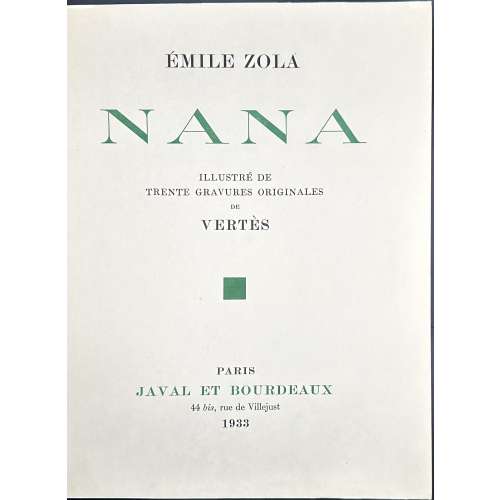 Publisher’s olive French flapped wrappers, in-4to, 33 x 25.3 x 6 cm, green and black lettering to front and spine, in a glassine dust jacket, in a marbled double slipcase 34.5 x 25.5 cm, unbound; pp.: [8] 1-436 [4], plus 30 colour plates with guard tissue, extraneous to collation; edition enriched with a set of 30 uncoloured etchings with guard tissue in a lettered paper folder. Title-page: ÉMILE ZOLA | NANA | ILLUSTRÉ DE | TRENTE GRAVURES ORIGINALES | DE | VERTÈS |◾| PARIS | JAVAL ET BOURDEAUX | 44 bis, rue de Villejust | 1933 || Justification du tirage: il a été tiré de «Nana » d'Émile Zola. Soixante exemplaires sur japon impérial, numérotés de 1 a 60, avec un état en couleurs colorié a la main et un état en noir des trente gravures originales de Vertès. [Edition limited to 60 copies, this is copy № 54]. Colophon: « NANA », D'ÉMILE ZOLA, ÉTÉ ACHEVÉ D'IMPRIMER LE TRENTE AVRIL MIL NEUF CENT TRENTE-TROIS, EN CARACTÈRES ROMAIN ANGLAIS DU CORPS 16, SUR LES PRESSES DU MAITRE IMPRIMEUR COULOUMA, À ARGENTEUIL, H. BARTHÉLEMY, DIRECTEUR. LES COMPOSITIONS DE VERTÈS ONT ÉTÉ REPRODUITES EN FAC-SIMILÉ PAR D. JACOMET & Cie. Printed on April 30, 1933 by Coulouma in Argenteuil, H. Barthélemy, director; illustrations reproduced in facsimile by D. Jacomet & Co. Catalogue raisonné: Vokaer 30. Contributors: Émile Zola (French, 1840 – 1902) – author. Marcel Vertès [Marcell Vértes] (Jewish-Hungarian-French, 1895 – 1961) – artist. Javal et Bourdeaux – publisher. Daniel Jacomet (French, 1894 – 1966) – printer. Seller's description: Nana. Paris, Javal et Bourdeaux, 1933. 2 volumes in-4, en feuilles, non coupé, non rogné, chemise et étui. Ouvrage illustré de 30 gravures originales en couleurs de Marcel Vertès. Tirage à 60 exemplaires sur japon impérial contenant un état des illustrations coloriées à la main en couleurs et un état en noir. Chemise et emboîtage insolés.
Publisher’s olive French flapped wrappers, in-4to, 33 x 25.3 x 6 cm, green and black lettering to front and spine, in a glassine dust jacket, in a marbled double slipcase 34.5 x 25.5 cm, unbound; pp.: [8] 1-436 [4], plus 30 colour plates with guard tissue, extraneous to collation; edition enriched with a set of 30 uncoloured etchings with guard tissue in a lettered paper folder. Title-page: ÉMILE ZOLA | NANA | ILLUSTRÉ DE | TRENTE GRAVURES ORIGINALES | DE | VERTÈS |◾| PARIS | JAVAL ET BOURDEAUX | 44 bis, rue de Villejust | 1933 || Justification du tirage: il a été tiré de «Nana » d'Émile Zola. Soixante exemplaires sur japon impérial, numérotés de 1 a 60, avec un état en couleurs colorié a la main et un état en noir des trente gravures originales de Vertès. [Edition limited to 60 copies, this is copy № 54]. Colophon: « NANA », D'ÉMILE ZOLA, ÉTÉ ACHEVÉ D'IMPRIMER LE TRENTE AVRIL MIL NEUF CENT TRENTE-TROIS, EN CARACTÈRES ROMAIN ANGLAIS DU CORPS 16, SUR LES PRESSES DU MAITRE IMPRIMEUR COULOUMA, À ARGENTEUIL, H. BARTHÉLEMY, DIRECTEUR. LES COMPOSITIONS DE VERTÈS ONT ÉTÉ REPRODUITES EN FAC-SIMILÉ PAR D. JACOMET & Cie. Printed on April 30, 1933 by Coulouma in Argenteuil, H. Barthélemy, director; illustrations reproduced in facsimile by D. Jacomet & Co. Catalogue raisonné: Vokaer 30. Contributors: Émile Zola (French, 1840 – 1902) – author. Marcel Vertès [Marcell Vértes] (Jewish-Hungarian-French, 1895 – 1961) – artist. Javal et Bourdeaux – publisher. Daniel Jacomet (French, 1894 – 1966) – printer. Seller's description: Nana. Paris, Javal et Bourdeaux, 1933. 2 volumes in-4, en feuilles, non coupé, non rogné, chemise et étui. Ouvrage illustré de 30 gravures originales en couleurs de Marcel Vertès. Tirage à 60 exemplaires sur japon impérial contenant un état des illustrations coloriées à la main en couleurs et un état en noir. Chemise et emboîtage insolés. -
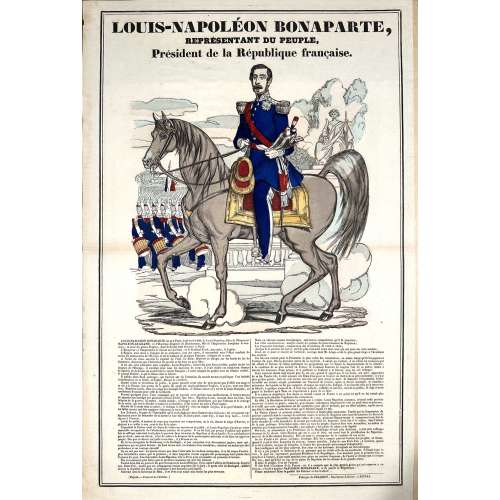 Hand-coloured woodcut poster on wove paper, 622 x 417 mm; black ink stamp “4859” to reverse, horizontal centrefold. In a double frame, top: LOUIS-NAPOLÉON BONAPARTE, | REPRÉSENTANT DU PEUPLE, | Président de la République française. Text under the image ; bottom left: (Déposé.— Propriété de l’Éditeur.); right: Fabrique de PELLERIN, Imprimeur-Libraire, à ÉPINAL. Jean Charles Pellerin (French, 1756 – 1836) – printer/publisher.
Hand-coloured woodcut poster on wove paper, 622 x 417 mm; black ink stamp “4859” to reverse, horizontal centrefold. In a double frame, top: LOUIS-NAPOLÉON BONAPARTE, | REPRÉSENTANT DU PEUPLE, | Président de la République française. Text under the image ; bottom left: (Déposé.— Propriété de l’Éditeur.); right: Fabrique de PELLERIN, Imprimeur-Libraire, à ÉPINAL. Jean Charles Pellerin (French, 1756 – 1836) – printer/publisher. -
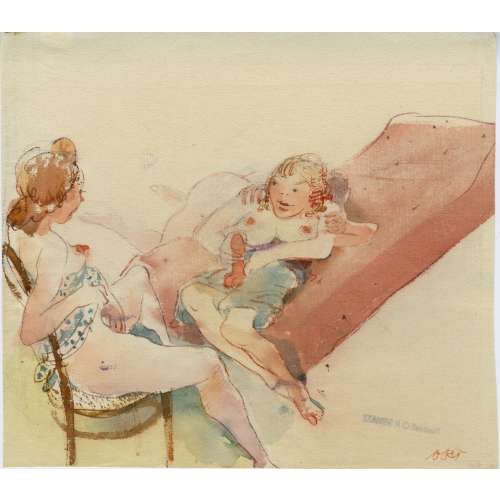 Watercolour on laid paper, 198 x 225 mm, signed or stamped in orange ink “ORS” to recto [Otto Rudolf Schatz (Austrian, 1900 – 1961)]; black ink stamp: “Nachlaß O R SCHATS”, pencil “ss” in the bottom left corner, and remnants of a hinge on the upper right to verso.
Watercolour on laid paper, 198 x 225 mm, signed or stamped in orange ink “ORS” to recto [Otto Rudolf Schatz (Austrian, 1900 – 1961)]; black ink stamp: “Nachlaß O R SCHATS”, pencil “ss” in the bottom left corner, and remnants of a hinge on the upper right to verso. -
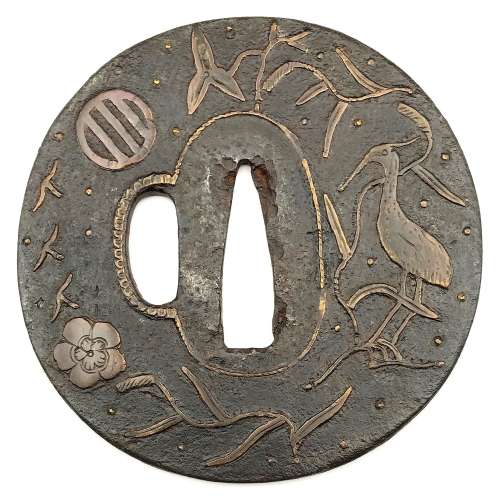 Iron tsuba of round form profusely decorated with brass inlay of plants, birds, well, and family crests (mon) in suemon-zōgan technique and occasional brass dots (nail-heads) or ten-zōgan. Seppa-dai and kozuka-hitsu-ana outlined with brass inaly, possibly repaired: rope-shaped wire here and there replaced with flat wire. The plate is very thin, with remnants of lacquer. Ōnin school. Size: 75.8 x 75.2 x 2.3 mm. Weight: 77.5 g. On the front side (omote) motif includes the following elements (from 12 o'clock, clockwise):
Iron tsuba of round form profusely decorated with brass inlay of plants, birds, well, and family crests (mon) in suemon-zōgan technique and occasional brass dots (nail-heads) or ten-zōgan. Seppa-dai and kozuka-hitsu-ana outlined with brass inaly, possibly repaired: rope-shaped wire here and there replaced with flat wire. The plate is very thin, with remnants of lacquer. Ōnin school. Size: 75.8 x 75.2 x 2.3 mm. Weight: 77.5 g. On the front side (omote) motif includes the following elements (from 12 o'clock, clockwise):- Water plantain (a.k.a. arrowhead, or omodaka): "a perpetual plant of the water plantain family, was also called shōgunsō (victorious army grass). Because of this martial connotation, it was a design favored for the crests of samurai families" [see: Family Crests of Japan. // Stone Bridge Press, Berkeley, CA, 2007; p. 63].
- Heron (sagi): "...considered an emblem of longevity, and from China comes the practice of regarding the bird as a mount of the gods and the Taoist sennin. [...] heron also reflects an inauspicious connotation, for the word sagi is homophone for 'fraud' and 'false pretenses'." [see: Merrily Baird. Symbols of Japan. Thematic motifs in art and design. // Rizzoli international publications, Inc., 2001; p. 112]. Some may say, that this is not a heron but a crane (tsuru). It's very possible, and in this case the negative connotation is lost, but the reference to longevity and allusion to sennin remain.
- Pampas grass (susuki, or obana): as per Merrily Baird, p. 95 and John W. Dower, p. 66, pampas grass is one of the Seven Grasses of Autumn. When combined with flying wild gees, conveys strong autumnal mood.
- Plum blossom (ume): according to Merrily Baird, the flower has a vast variety of symbolic meanings, including longevity, and a reference to the Chinese Taoists. It is used in 80 family crests [see: Japanese Design Motifs: 4,260 Illustrations of Japanese Crests; Compiled by the Matsuya Piece-Goods Store; Translated by Fumie Adachi. // Dover Publications, Inc., 1972.] Plum is "celebrated for its sweet perfume, delicate blossoms, and habit of blooming at the end of winter".
- Tree flying wild geese (kari): "Wild geese arrive in large flocks in southern regions during the autumn months, and following their migratory instincts, head back north in spring" [Family Crests of Japan, pp. 85-86]. "The importance of geese in Japanese art was further secured by stories of several military heroes who had achieved victory in battle when a sudden breaking of ranks by flying geese signaled an ambush. The protective role of the birds led to their frequent use in decorating sword furnishings and possibly also their adoption as a family crest motif.Finally, the goose in Asia plays a role in religious traditions" [Merrily Baird, pp.111-112].
- Hikiryō (line, or bar, or stripe) - a symbol which consists of one, two, or three horizontal or vertical stripes in a circle. "In wartime, Japanese generals [...] surrounded their encampments with huge cloth curtains. Usually these were made of cloth sewn together horizontally and varying in color [...] to distinguish the individual general and his followers. The stripe thus assumed strong martial connotations, and became a mark of identification on personal military gear as well. In the early fourteenth century the heads of the Ashikaga and Nitta, then the two most powerful clans in Japan, both adopted stripe patterns as a family crest". [See: Family Crests of Japan, p. 111 and John W. Dower. The elements of Japanese design - A handbook of family crests, heraldry & symbolism. // Weatherhill, New York, Tokyo, 1985, p. 144].
- Hikiryō, see above.
- Pampas grass (susuki, or obana), see above.
- Bellflower (kikyo): One of the Seven Grasses of Autumn. "As a crest, it have been adopted among the warriors around the thirteenth century, primarily because of it's beauty" [John W. Dower, p. 48].
- Four flying wild geese (kari), see above.
- Weeping willow (yanagi): "It is commonly represented with water, snow, swallows, or herons. A branch of willow (yoshi) is one of the attributes of the Buddhist deity Senju Kannon (Thousand-Armed Kannon), who is said to use the branch to sprinkle the nectar of life contained in a vase. [Merrily Baird, pp. 66-67].
- Lone plum blossom in a well frame/crib (igeta, izitsu): "Well crib was one of the most popular motifs in Japanese heraldry". As a crest it may stay simply for the first character (i) of the family name, however, with a flower inside the well frame, and together with the other symbols present, it may aggravate the sense of autumn-ness. The ten-zōgan dots in this particular case may represent the snowflakes or autumn stars.
-

Bertrand Russell. A history of western philosophy. A Touchstone Book. Published by Symon & Schuster, 2007. [Reprint 1945].
ISBN-10: 1-4165-5477-7
ISBN-13: 978-4165-5477-6.
-
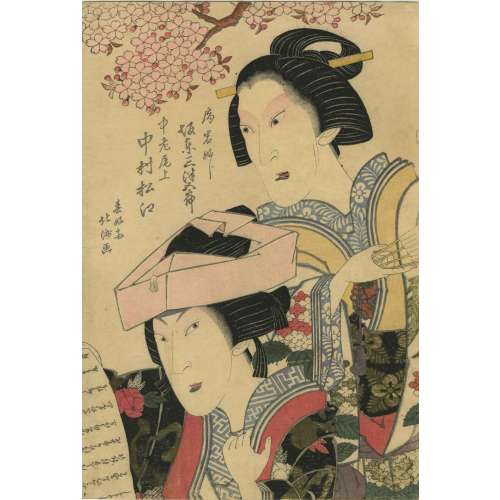 Bando Mitsugorō III as Lady Iwafuji and Nakamura Matsue III as Lady Onoe, 1821.「局岩ふじ 坂東三津五郎」(三代)、「中老尾上 中村松江」(三代) in kabuki play Kagamiyama Kokyô no Nishikie [鏡山旧錦繪] (Mirror mountain: A women’s treasury of loyalty); author: Yô Yôdai. Artist: Shunkōsai Hokushū (春好斎 北洲), who is also known as Shunkō IV, active from about 1802 to 1832. Actors: Bandō Mitsugorō III [三代目 坂東 三津五郎] (Japanese, 1775 – 1831); other names: Bandō Minosuke I, Morita Kanjirô II, Bandō Mitahachi I, Bandō Minosuke I, Bandō Mitahachi I. Nakamura Matsue III [三代目中村松江] (Japanese, 1786-1855); other names: Nakamura Sankō I, Nakamura Tomijūrō II, Ichikawa Kumatarō. Year: 1821 (Bunsei 4), 1st month. Publisher: Wataya Kihei (Wataki) (Japanese, fl. c. 1809 – 1885) Signed Shunkôsai Hokushû ga 春好斎北洲画. MFA Accession № 11.35375. MFA description: "Play: Keisei Kagamiyama (Mirror Mountain, a Courtesan Play). Theatre: Kado けいせい双鏡山(けいせいかがみやま)角. Ref.: [LIB-1193.2013] Leiter. Kabuki Encyclopedia, p. 156; [LIB-0879-2.2015] Kabuki plays on stage (vol. 2): 1773-1799, pp. 172-212.
Bando Mitsugorō III as Lady Iwafuji and Nakamura Matsue III as Lady Onoe, 1821.「局岩ふじ 坂東三津五郎」(三代)、「中老尾上 中村松江」(三代) in kabuki play Kagamiyama Kokyô no Nishikie [鏡山旧錦繪] (Mirror mountain: A women’s treasury of loyalty); author: Yô Yôdai. Artist: Shunkōsai Hokushū (春好斎 北洲), who is also known as Shunkō IV, active from about 1802 to 1832. Actors: Bandō Mitsugorō III [三代目 坂東 三津五郎] (Japanese, 1775 – 1831); other names: Bandō Minosuke I, Morita Kanjirô II, Bandō Mitahachi I, Bandō Minosuke I, Bandō Mitahachi I. Nakamura Matsue III [三代目中村松江] (Japanese, 1786-1855); other names: Nakamura Sankō I, Nakamura Tomijūrō II, Ichikawa Kumatarō. Year: 1821 (Bunsei 4), 1st month. Publisher: Wataya Kihei (Wataki) (Japanese, fl. c. 1809 – 1885) Signed Shunkôsai Hokushû ga 春好斎北洲画. MFA Accession № 11.35375. MFA description: "Play: Keisei Kagamiyama (Mirror Mountain, a Courtesan Play). Theatre: Kado けいせい双鏡山(けいせいかがみやま)角. Ref.: [LIB-1193.2013] Leiter. Kabuki Encyclopedia, p. 156; [LIB-0879-2.2015] Kabuki plays on stage (vol. 2): 1773-1799, pp. 172-212. -
 Iron tsuba of round form with design of military commander's fan (gunbai) in openwork (sukashi). Square rim. Hitsu-ana plugged with lead or tin. Ko-tosho school. Mid Muromachi period. Late 15th century: Entoku era [1489-92] / Meio era [1489-1501]. Height: 80.3 mm, Width: 81.5 mm, Rim thickness: 3.0 mm. Centre thickness: 3.5 mm. Provenance: Sasano Masayuki Collection, №23 in Japanese Sword Guard Masterpieces from the Sasano Collection, 1994: Ko-tosho. Sukashi design: Military commander's fan (gunbai). Mid Muromachi period. Late 15th century (Entoku / Meio era). The military commander's fan (gunbai) was cherished by samurai warriors. This tsuba is relatively thick, with the large fan nicely positioned on the plate.
Iron tsuba of round form with design of military commander's fan (gunbai) in openwork (sukashi). Square rim. Hitsu-ana plugged with lead or tin. Ko-tosho school. Mid Muromachi period. Late 15th century: Entoku era [1489-92] / Meio era [1489-1501]. Height: 80.3 mm, Width: 81.5 mm, Rim thickness: 3.0 mm. Centre thickness: 3.5 mm. Provenance: Sasano Masayuki Collection, №23 in Japanese Sword Guard Masterpieces from the Sasano Collection, 1994: Ko-tosho. Sukashi design: Military commander's fan (gunbai). Mid Muromachi period. Late 15th century (Entoku / Meio era). The military commander's fan (gunbai) was cherished by samurai warriors. This tsuba is relatively thick, with the large fan nicely positioned on the plate. -
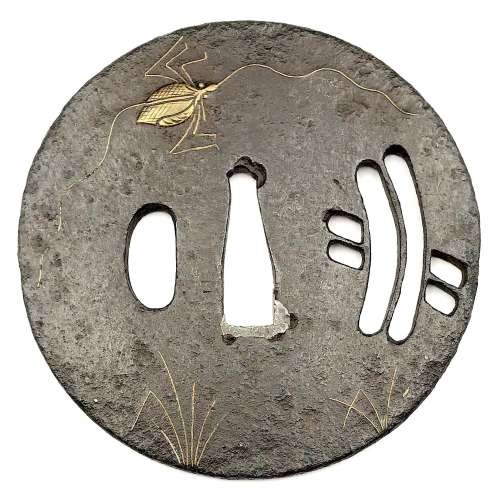 Iron tsuba with design of a cricket and grass inlaid in brass (suemon-zōgan) and a bridge over a stream in openwork (sukashi) on both sides. Inlay of distant part of the cricket's antenna is missing. Heianjō School. Momoyama period. Diameter: 79.5 mm, thickness at seppa-dai: 3.3 mm NBTHK # 4002100.
Iron tsuba with design of a cricket and grass inlaid in brass (suemon-zōgan) and a bridge over a stream in openwork (sukashi) on both sides. Inlay of distant part of the cricket's antenna is missing. Heianjō School. Momoyama period. Diameter: 79.5 mm, thickness at seppa-dai: 3.3 mm NBTHK # 4002100. -
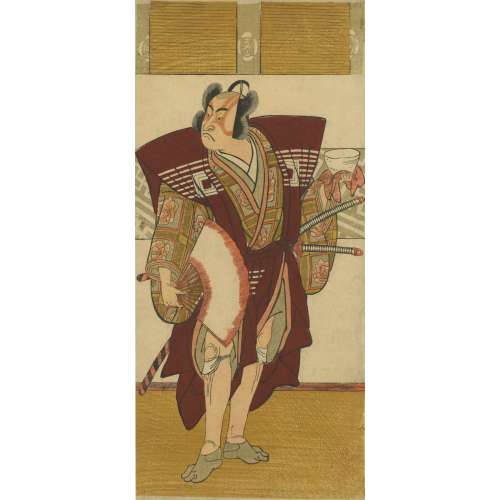 An unsigned print, presumably by Katsukawa Shunshō that presumably depicts a kabuki actor Ichikawa Monnosuke II. I was not able to find any reference of the image. Size: Hosoban. According to The actor's image. Print makers of the Katsukawa School. Timothy T. Clark and Osamu Ueda with Donald Jenkins. Naomi Noble Richard, editor The Art Institute of Chicago in association with Princeton University Press, 1994, Ichikawa Monnosuke II was born in 1743, in Ōji Takinogawa, Edo. He died on October 19, 1974. His specialities were young male roles (wakashu) and male leads (tachi yaku). He was considered to be one of the four best young actors of his day.
An unsigned print, presumably by Katsukawa Shunshō that presumably depicts a kabuki actor Ichikawa Monnosuke II. I was not able to find any reference of the image. Size: Hosoban. According to The actor's image. Print makers of the Katsukawa School. Timothy T. Clark and Osamu Ueda with Donald Jenkins. Naomi Noble Richard, editor The Art Institute of Chicago in association with Princeton University Press, 1994, Ichikawa Monnosuke II was born in 1743, in Ōji Takinogawa, Edo. He died on October 19, 1974. His specialities were young male roles (wakashu) and male leads (tachi yaku). He was considered to be one of the four best young actors of his day. -
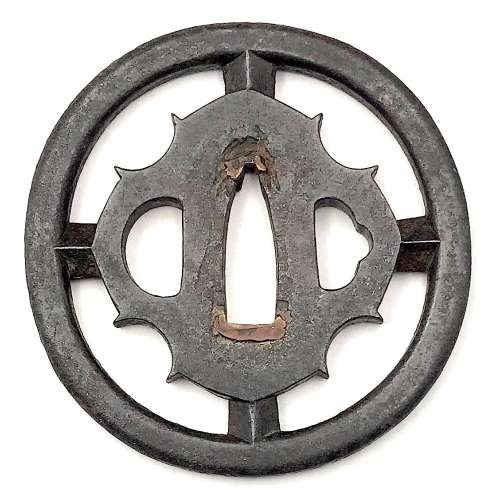 Iron tsuba of round form with slanting rays of light (shakoh) Christian motif (Jesuit's IHS symbol) in openwork (sukashi). Traditional description of this kind of design is called "tokei", or "clock gear". Edo period.
Iron tsuba of round form with slanting rays of light (shakoh) Christian motif (Jesuit's IHS symbol) in openwork (sukashi). Traditional description of this kind of design is called "tokei", or "clock gear". Edo period.Size: 77.7 x 76.1 x 6.7 mm.
For information regarding shakoh tsuba see article 'Kirishitan Ikenie Tsuba" by Fred Geyer at Kokusai Tosogu Kai; The 2nd International Convention & Exhibition, October 18-23, 2006, pp. 84-91. -
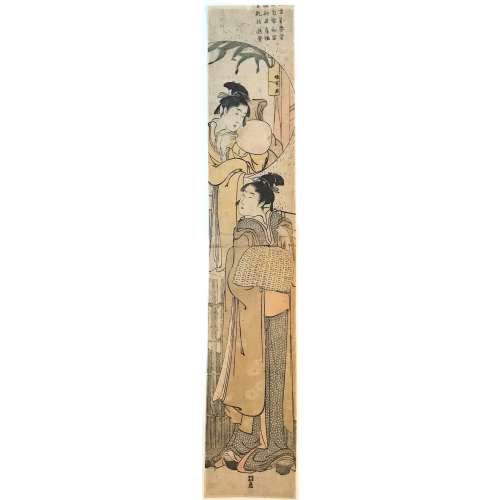 Woman Looking out a Round Window at a Woman with a Komusō Hat.
Woman Looking out a Round Window at a Woman with a Komusō Hat.Artist Koikawa Harumasa (a.k.a. Banki): fl. 1801–18. Wikipedia: Koikawa Harumasa (恋川 春政; active 1800–1820), later called Banki Harumasa (晩器 春政). Associated with Katsukawa school.
Signed: Banki ga (on the bamboo flower container in the background). Censor's seal: kiwame. Mark of unidentified publisher, Genshoku #1017; Marks U084 Ibiko, p. 387.
References:
Jacob Pins #828.
-
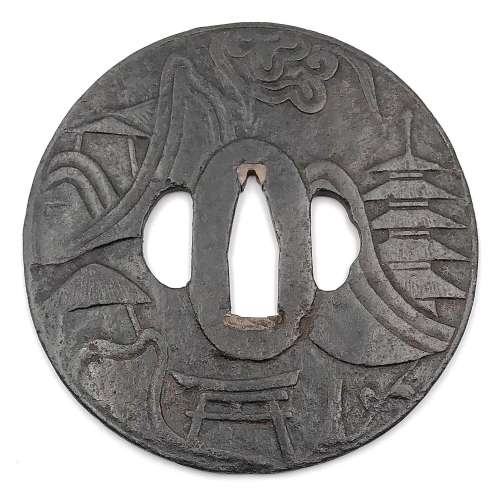
Thin iron plate of round form and black color carved in sukidashi-bori with design of rocks, waves, clouds, temple gates (torii), mountain pavilion and 5-storey pagoda on both sides, alluding to Todai-ji temple in Nara. Hitsu-ana pierced later. Very narrow very slightly raised rim. Copper sekigane.
Late Muromachi period, 16th century. Dimensions: 88.7 x 88.0 x 2.4 mm (seppa-dai), 1.8 mm (base plate).Reference: “Art of the Samurai” on page 232, №140: ”Kamakura tsuba with Sangatsu-do tower and bridge. Muromachi period, 16th century. 83 mm x 80 mm. Unsigned. Tokyo National Museum. The mountain pavilion and bridge carved in sunken relief on the iron tsuba – both part of Tōdai-ji, a temple in Nara – are detailed in fine kebori (line) engraving. As a result of the chiseling used to create the relief, the ground of the piece is relatively thin".
-
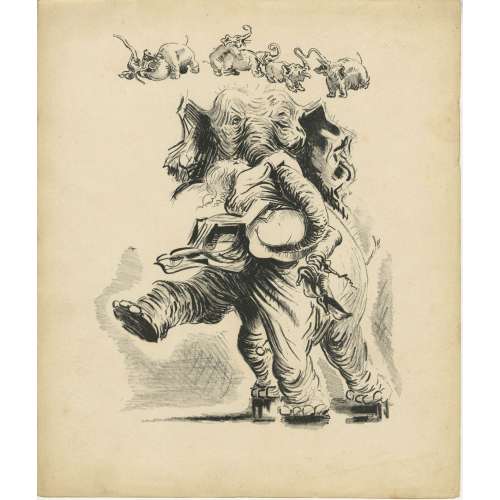
Album of 20 hand-coloured lithographs with a title page and a 'justification du tirage' page in an original snakeskin-clothed cardboard binder. Drawn on stone by Anonymous, attributed to Santippa. The theme of these pictures can be described as erotic humour.
Edition: 200 copies printed in Bruxelles, c. 1938; this copy without a number.
Watermarked wove paper: Word "Marais" and a flower.
Dimensions: 24.3 x 29.3 cm According to J.-P. Dutel, the author of these images is Georges Hoffmann under the pseudonym Santippa. Honesterotica provides a different name: Gaston Hoffmann [Santippa] (French, 1883 – 1977), which seems adequate. Catalogue raisonné: Dutel (1920-70): 2496. -
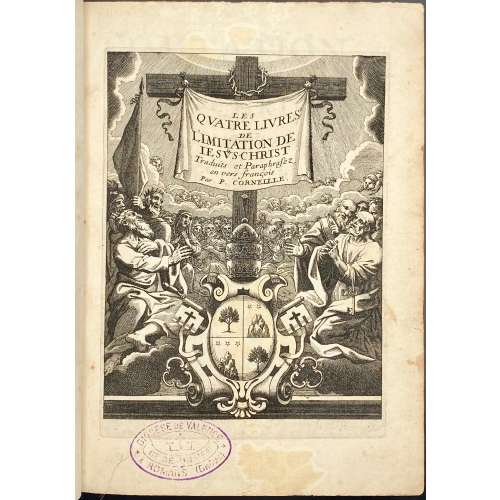 L'Imitation de Jésus-Christ / Traduite et paraphrasée en Vers François Par P. Corneille. — A Paris, Chez Pierre Rocolet, Imprimeur & Libraire ordinaire du Roy, au Palais, en la Gallerie des Prisonniers, aux Armes du Roy & de la Ville. M. DC. LVI. Avec Approbation des Docteurs, et Privelege de sa Majesté. Paris: Pierre Rocolet, 1656. Half-title: Les Quatre Livres de L'Imitation de Iesus-Christ. Traduites et paraphrasez en vers françois Par P. Corneille. — pp.: ff [2 pictorial ht, verso blank] [2 title, blank] [10 epistre] [2 av lecteur] [2 approbation, frontis.] 1-551 [552-60 table, privilege] bf. 8vo, 24.7 x 18.7 cm, hardcover; full speckled brown calf, gilt double-ruled boards, spine with raised bands, gilt double-ruled compartments with lozenges, sprayed margins; pages darkened. Purple ink stamp of Diocèse de Valencia to half-title. Nut ink ex libris handwriting on front paste-down. Plates: Half-title: unsigned copper engraving with the coat of arms of Pope Alexander VII (r. 1655 – 1667) which contains an oak tree in the top left and bottom right quarters (from Della Rovere family, Dukes of Urbino), the top right and bottom left quarters feature a mountain of six coupeaux in base with three stars above (from Chigi family). Four copper engravings inbound at the beginning of each book signed 'F. Chauueau in et fe.': Page 1: Jesus teaches His disciple. Page 113: Annunciation. Page 183: Jesus meets Simon called Peter and his brother Andrew. Page 459: Last Supper. François Chauveau (10 May 1613, Paris – 3 February 1676, Paris), a French painter and engraver. Thomas à Kempis (c. 1380 – 25 July 1471), a German-Dutch canon regular. Pierre Corneille (1606 – 1684), a French poet and playwright. Pierre Rocolet (1610 – 1662, active circa 1638 à 1662), a French publisher and printer.
L'Imitation de Jésus-Christ / Traduite et paraphrasée en Vers François Par P. Corneille. — A Paris, Chez Pierre Rocolet, Imprimeur & Libraire ordinaire du Roy, au Palais, en la Gallerie des Prisonniers, aux Armes du Roy & de la Ville. M. DC. LVI. Avec Approbation des Docteurs, et Privelege de sa Majesté. Paris: Pierre Rocolet, 1656. Half-title: Les Quatre Livres de L'Imitation de Iesus-Christ. Traduites et paraphrasez en vers françois Par P. Corneille. — pp.: ff [2 pictorial ht, verso blank] [2 title, blank] [10 epistre] [2 av lecteur] [2 approbation, frontis.] 1-551 [552-60 table, privilege] bf. 8vo, 24.7 x 18.7 cm, hardcover; full speckled brown calf, gilt double-ruled boards, spine with raised bands, gilt double-ruled compartments with lozenges, sprayed margins; pages darkened. Purple ink stamp of Diocèse de Valencia to half-title. Nut ink ex libris handwriting on front paste-down. Plates: Half-title: unsigned copper engraving with the coat of arms of Pope Alexander VII (r. 1655 – 1667) which contains an oak tree in the top left and bottom right quarters (from Della Rovere family, Dukes of Urbino), the top right and bottom left quarters feature a mountain of six coupeaux in base with three stars above (from Chigi family). Four copper engravings inbound at the beginning of each book signed 'F. Chauueau in et fe.': Page 1: Jesus teaches His disciple. Page 113: Annunciation. Page 183: Jesus meets Simon called Peter and his brother Andrew. Page 459: Last Supper. François Chauveau (10 May 1613, Paris – 3 February 1676, Paris), a French painter and engraver. Thomas à Kempis (c. 1380 – 25 July 1471), a German-Dutch canon regular. Pierre Corneille (1606 – 1684), a French poet and playwright. Pierre Rocolet (1610 – 1662, active circa 1638 à 1662), a French publisher and printer. -
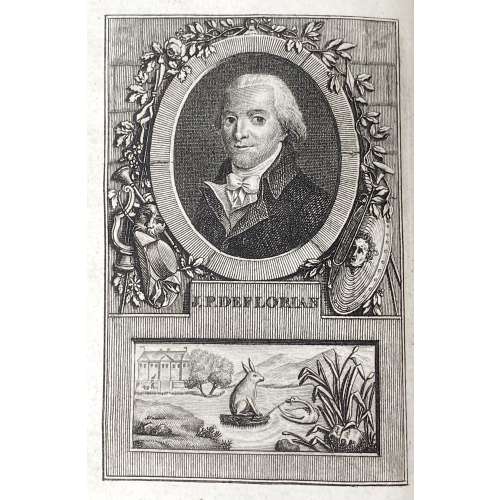 Title: FABLES | DE | M. DE FLORIAN , | de l’académie françoise, de celles de Madrid , | Florence, etc. | — | Je tâche d'y tourner le vice ridicule , | Ne pouvant l'attaquer avec des bras d'Hercule. | La Font. Fables , liv. V , I. — | [publisher's device ] | A PARIS, | DE L'IMPRIMERIE DE P. DIDOT L'AINÉ, | 1792. Pagination: ffl, [2 - h.t. / Imp.] [2 - blank / frontis.] [2 - tp. / blank] [5] 6-224 [2 - advert. / blank], bfl. Collation: numbered 1(5), 2-18(6), 19(3); engarved frontispiece portrait of Florian after François Hüet-Villiers, 5 engraved plates by Longueil, Delignon, and Gaucher after Flouest. Binding: Contemporary full mottled calf, all margins red, gilt floral ornaments to flat spine, red label with gilt lettering. Catalogue raisonné: Cohen, de Ricci 1912: p. 398-9.
Title: FABLES | DE | M. DE FLORIAN , | de l’académie françoise, de celles de Madrid , | Florence, etc. | — | Je tâche d'y tourner le vice ridicule , | Ne pouvant l'attaquer avec des bras d'Hercule. | La Font. Fables , liv. V , I. — | [publisher's device ] | A PARIS, | DE L'IMPRIMERIE DE P. DIDOT L'AINÉ, | 1792. Pagination: ffl, [2 - h.t. / Imp.] [2 - blank / frontis.] [2 - tp. / blank] [5] 6-224 [2 - advert. / blank], bfl. Collation: numbered 1(5), 2-18(6), 19(3); engarved frontispiece portrait of Florian after François Hüet-Villiers, 5 engraved plates by Longueil, Delignon, and Gaucher after Flouest. Binding: Contemporary full mottled calf, all margins red, gilt floral ornaments to flat spine, red label with gilt lettering. Catalogue raisonné: Cohen, de Ricci 1912: p. 398-9. -
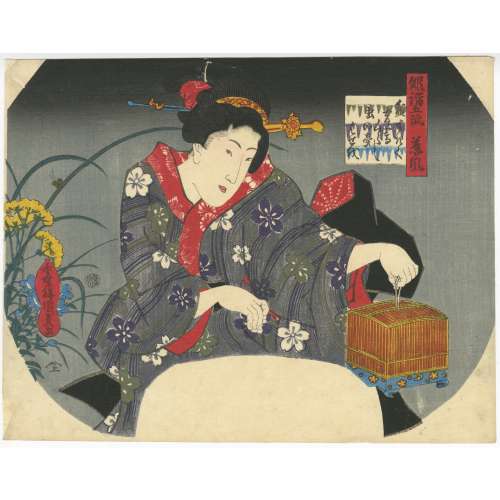 Artist: Utagawa Kunisada [歌川 国貞] a.k.a. Utagawa Toyokuni III [三代 歌川 豊国] (Japanese, 1786 – 1865). Signed: Kōchōrō Kunisada ga [香蝶楼国貞画] in a double-gourd cartouche. Iseya Sōemon [伊勢屋惣右衛門] (Japanese, 1776 – 1862); seal: Ue [上] (Marks 02-041 | 156a). Inscription in the red stripe: Five types of haiku in shōfū style [俳諧五流蕉風] (Haikai gōryū shōfū). Censor's seal: Watari [渡] (Watanabe Shōemon), VI/1842–V ic/1846. Media: Fan print [団扇絵] (Uchiwa-e); size: 225 x 292 mm. An uncut fan print depicts a young woman with an insect (firefly) cage in her left hand. Her striped kimono is adorned with the design of white, grey and blue cherry blossoms. Two of the Seven Grasses of Autumn [秋の七草] (aki no nanakusa), namely Platycodon grandiflorus (kikyō) [桔梗] a.k.a. Chinese bellflower (or balloon flower) and Patrinia scabiosifolia (ominaeshi) [女郎花] a. k.a. Eastern (or Golden) Valerian, are seen on her right-hand side.
Artist: Utagawa Kunisada [歌川 国貞] a.k.a. Utagawa Toyokuni III [三代 歌川 豊国] (Japanese, 1786 – 1865). Signed: Kōchōrō Kunisada ga [香蝶楼国貞画] in a double-gourd cartouche. Iseya Sōemon [伊勢屋惣右衛門] (Japanese, 1776 – 1862); seal: Ue [上] (Marks 02-041 | 156a). Inscription in the red stripe: Five types of haiku in shōfū style [俳諧五流蕉風] (Haikai gōryū shōfū). Censor's seal: Watari [渡] (Watanabe Shōemon), VI/1842–V ic/1846. Media: Fan print [団扇絵] (Uchiwa-e); size: 225 x 292 mm. An uncut fan print depicts a young woman with an insect (firefly) cage in her left hand. Her striped kimono is adorned with the design of white, grey and blue cherry blossoms. Two of the Seven Grasses of Autumn [秋の七草] (aki no nanakusa), namely Platycodon grandiflorus (kikyō) [桔梗] a.k.a. Chinese bellflower (or balloon flower) and Patrinia scabiosifolia (ominaeshi) [女郎花] a. k.a. Eastern (or Golden) Valerian, are seen on her right-hand side. -
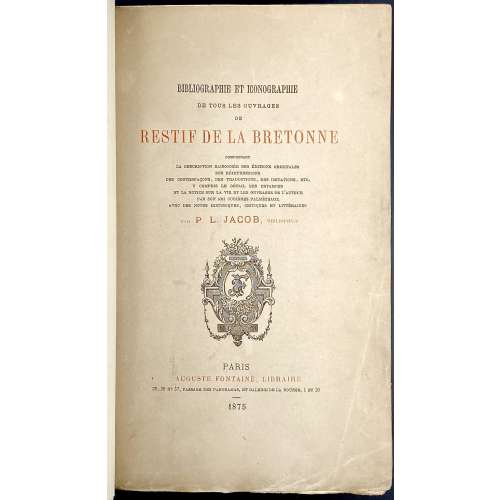 Title: BIBLIOGRAPHIE ET ICONOGRAPHIE | DE TOUS LES OUVRAGES | DE | RESTIF DE LA BRETONNE | COMPRENANT | LA DESCRIPTION RAISONNÉE DES ÉDITIONS ORIGINALES | DES RÉIMPRESSIONS | DES CONTREFAÇONS, DES TRADUCTIONS, DES IMITATIONS, ETC. | Y COMPRIS LE DÉTAIL DES ESTAMPES | ET LA NOTICE SUR LA VIE ET LES OUVRAGES DE L'AUTEUR | PAR SON AMI CUBIÈRES PALMÉZEAUX | AVEC DES NOTES HISTORIQUES, CRITIQUES ET LITTÉRAIRES | PAR P. L. JACOB, BIBLIOPHILE | {Publisher’s device} | PARIS | AUGUSTE FONTAINE, LIBRAIRE | 35, 36 ET 37 PASSAGE DES PANORAMAS, ET GALERIE DE LA BOURSE, 1 ET 10 | 1875 || Pagination: ffl, 1 leaf with owner’s engraved ex libris, orig. tan wrapper w/lettering, 1 blank leaf, [2] – h.t. / tirage, 453 of 500, frontis. Portrait, [2] – t.p. / blank, [i] ii-xv [xvi blank], [1] 2-510, [2] – imprint / blank, [1] 2-8 advert., 1 blank leaf, orig. back wrapper, orig. spine, bfl. Note: pp. starting from p. 76 and up to p. 455, between every two leaves of text, there are leaves of grid paper bound in, some with the reader’s handwritten ink remarks. Collation: Prelims., 8vo; a8, 1-328 + advert. Binding: ¾ brown morocco over marbled boards, spine with raised bands and gilt lettering, peacock marbled endpapers. Original wrappers preserved. Size: 23.5 x 14 x 8 cm. Provenance: Juan Hernandez bookplate engraved on a laid and watermarked paper sheet and including a library storage № 2272 The catalogue is produced by Paul Lacroix (French, 1806 – 1884) under the pseudonym of P. L. Jacob; the essay of Restif de La Bretonne biography – by Barbier Michel Cubières de Palmeseaux (French, 1752 – 1820). Frontispice: engraved portrait of Nicolas-Edme Restif de La Bretonne (French, 1734 – 1806) by Eugène Loizelet (French, 1842 – 1882) after Louis Berthet (French, fl. 1775 – 1808) after Louis Binet (French, 1744 – c. 1800).
Title: BIBLIOGRAPHIE ET ICONOGRAPHIE | DE TOUS LES OUVRAGES | DE | RESTIF DE LA BRETONNE | COMPRENANT | LA DESCRIPTION RAISONNÉE DES ÉDITIONS ORIGINALES | DES RÉIMPRESSIONS | DES CONTREFAÇONS, DES TRADUCTIONS, DES IMITATIONS, ETC. | Y COMPRIS LE DÉTAIL DES ESTAMPES | ET LA NOTICE SUR LA VIE ET LES OUVRAGES DE L'AUTEUR | PAR SON AMI CUBIÈRES PALMÉZEAUX | AVEC DES NOTES HISTORIQUES, CRITIQUES ET LITTÉRAIRES | PAR P. L. JACOB, BIBLIOPHILE | {Publisher’s device} | PARIS | AUGUSTE FONTAINE, LIBRAIRE | 35, 36 ET 37 PASSAGE DES PANORAMAS, ET GALERIE DE LA BOURSE, 1 ET 10 | 1875 || Pagination: ffl, 1 leaf with owner’s engraved ex libris, orig. tan wrapper w/lettering, 1 blank leaf, [2] – h.t. / tirage, 453 of 500, frontis. Portrait, [2] – t.p. / blank, [i] ii-xv [xvi blank], [1] 2-510, [2] – imprint / blank, [1] 2-8 advert., 1 blank leaf, orig. back wrapper, orig. spine, bfl. Note: pp. starting from p. 76 and up to p. 455, between every two leaves of text, there are leaves of grid paper bound in, some with the reader’s handwritten ink remarks. Collation: Prelims., 8vo; a8, 1-328 + advert. Binding: ¾ brown morocco over marbled boards, spine with raised bands and gilt lettering, peacock marbled endpapers. Original wrappers preserved. Size: 23.5 x 14 x 8 cm. Provenance: Juan Hernandez bookplate engraved on a laid and watermarked paper sheet and including a library storage № 2272 The catalogue is produced by Paul Lacroix (French, 1806 – 1884) under the pseudonym of P. L. Jacob; the essay of Restif de La Bretonne biography – by Barbier Michel Cubières de Palmeseaux (French, 1752 – 1820). Frontispice: engraved portrait of Nicolas-Edme Restif de La Bretonne (French, 1734 – 1806) by Eugène Loizelet (French, 1842 – 1882) after Louis Berthet (French, fl. 1775 – 1808) after Louis Binet (French, 1744 – c. 1800). -
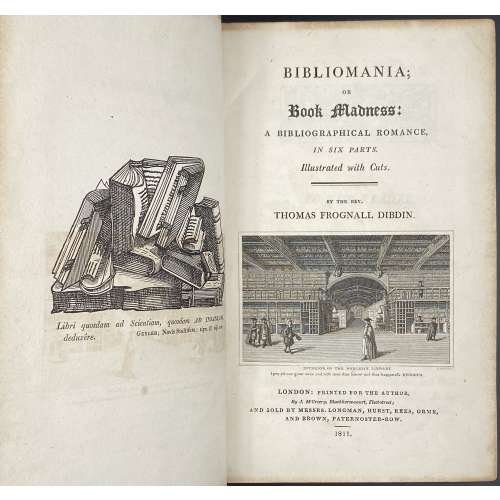 Title: BIBLIOMANIA; | OR | Book Madness: | A BIBLIOGRAPHICAL ROMANCE, | IN SIX PARTS. | Illustrated with Cuts. | BY THE REV. | THOMAS FROGNALL DIBDIN. | {vignette} | INTERIOR OF THE BODLEIAN LIBRARY | I pity all our great ones and rich men that know not this happiness. HEINSIUS. | LONDON: PRINTED FOR THE AUTHOR, | By J. McCreery, Blackhorse-court, Fleet-street; | AND SOLD BY MESSRS. LONGMAN, HURST, REES, ORME, | AND BROWN, PATERNOSTER-ROW. | 1811.|| Pagination: ffl, [i, ii] - ht, frontis., [iii, iv] - t.p., blank, [v]vi-ix - to the reader, [x] - blank, [2] - contents, [1, 2] - part 1 fl. t.p., blank, [3] - woodcut frame and capital I, 4-782 (imprint to p. 782) [2] - errata, blank, bfl; 1 plate op. p. 158. Collation: [A]6 B-Z8 2A-2Z8, 3A-3B8, 3C-3F4. Binding: 8vo, 23 x 14 cm, modern full dark brown calf by Period Binders (Bath, England), gilt fillet border to boards, raised bands with gilt ornaments and lettering to spine, pp. 685-688 an open tear in upper 1/8 of lateral margin, all margins marbled. Substantially revised 1st edition ("so much altered and enlarged, as to assume the character of a new work"). Author: Thomas Frognall Dibdin (British, 1776 – 1847).
Title: BIBLIOMANIA; | OR | Book Madness: | A BIBLIOGRAPHICAL ROMANCE, | IN SIX PARTS. | Illustrated with Cuts. | BY THE REV. | THOMAS FROGNALL DIBDIN. | {vignette} | INTERIOR OF THE BODLEIAN LIBRARY | I pity all our great ones and rich men that know not this happiness. HEINSIUS. | LONDON: PRINTED FOR THE AUTHOR, | By J. McCreery, Blackhorse-court, Fleet-street; | AND SOLD BY MESSRS. LONGMAN, HURST, REES, ORME, | AND BROWN, PATERNOSTER-ROW. | 1811.|| Pagination: ffl, [i, ii] - ht, frontis., [iii, iv] - t.p., blank, [v]vi-ix - to the reader, [x] - blank, [2] - contents, [1, 2] - part 1 fl. t.p., blank, [3] - woodcut frame and capital I, 4-782 (imprint to p. 782) [2] - errata, blank, bfl; 1 plate op. p. 158. Collation: [A]6 B-Z8 2A-2Z8, 3A-3B8, 3C-3F4. Binding: 8vo, 23 x 14 cm, modern full dark brown calf by Period Binders (Bath, England), gilt fillet border to boards, raised bands with gilt ornaments and lettering to spine, pp. 685-688 an open tear in upper 1/8 of lateral margin, all margins marbled. Substantially revised 1st edition ("so much altered and enlarged, as to assume the character of a new work"). Author: Thomas Frognall Dibdin (British, 1776 – 1847).


